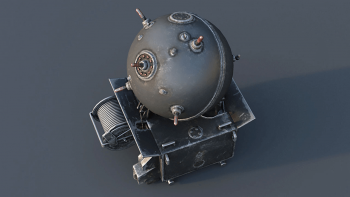EMC mine
Contents
Description
Write an introduction to the article in 2-3 small paragraphs. Briefly tell us about the history of the development and combat using the weaponry and also about its features. Compile a list of air, ground, or naval vehicles that feature this weapon system in the game.
Vehicles equipped with this weapon
General info
Tell us about the tactical and technical characteristics of the mine.
Effective damage
Describe the type of damage produced by this type of mine (high explosive, splash damage, etc)
Comparison with analogues
Give a comparative description of mines that have firepower equal to this weapon.
Usage in battles
Describe situations when you would utilise this mine in-game (vehicle, pillbox, base, etc)
Pros and cons
Summarise and briefly evaluate the weaponry in terms of its characteristics and combat effectiveness. Mark pros and cons as a list.
Pros:
Cons:
History
German mines had a high reputation in both World Wars for reliability and innovation. The British paid perhaps the ultimate compliment in 1917 by copying a captured German Hertz horned mine to produce their first reliable contact mine. Following World War I, Germany established a mine warfare research and development command in 1920. Airborne mines were successfully tested in 1931 and acoustic and magnetic mines were developed before the war started. Some 1,500 magnetic mines were available in the spring of 1940, far short of the 50,000 originally ordered. Pressure mines were developed in 1943 but not used until the night of 6-7 June 1944 in the Normandy invasion area. This late deployment was to avoid their capture and duplication by the Allies. However, the Allies had already developed their own but had not used them for similar reasons. German pressure mines that could not be swept were nearly ready for deployment at the end of the war. Postwar, Germany used British and USA mines until the 1960s, at which time Denmark and Germany began cooperating in developing a new generation of magnetic ground mines.
German mines of World War II were all designated by letters, the first two indicating the function and the third the series designation within that category, usually indicating a modification.
EM stood for Einheits Minen, "Unity Mine" or Elektrische Minen, "Electrical Mine", and was a series of, with one exception, 13 different types of moored contact sea mines; EMA through EMI, EMK, EMR, EMS and EMU. With the exception of the EMS type, all of these were moored mines which could be laid by surface ships or by submarines. The EMH, EMJ, EMK and EMU types were either abandoned during the developmental stage or were incomplete at the end of the war.
The EMC was a spherical mine 44 inch (1.12 m) in diameter, and with a charge of 661 lbs. (300 kg). It used 7 Hertz horns as triggering devices. It could be moored in 55, 109, 164 or 273 fathoms (100, 200, 300 or 500 m).[1]
Media
Excellent additions to the article would be video guides, screenshots from the game, and photos.
See also
Links to the articles on the War Thunder Wiki that you think will be useful for the reader, for example:
- reference to the article about the variant of the weapon;
- references to approximate analogues by other nations and research trees.
External links
Paste links to sources and external resources, such as:
- topic on the official game forum;
- encyclopedia page on the weapon;
- other literature.
| Naval mines | |
|---|---|
| USA | Type A Mark I* |
| Germany | EMC · EMF · UDM-E |
| USSR | KB-1 pattern 1931 mine · KB-3 pattern 1940 · MIRAB · YAM-43 |
| Britain | Type M Mark I |
| Japan | Mk.6 mod1 · Type 93 mod1 |
| Italy | Bollo P.125/1932 · Bollo P.200/1936 |
| France | B4M |
| * = Aircraft-laid | |




